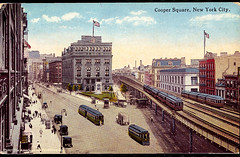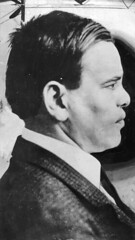Eleven days ago, the arrest of nearly 125 mobsters reacquainted many to the fact that the mob still has life outside of the occasional H.B.O. series. Federal officials labeled the bust “the largest mob roundup in F.B.I. history,” and once the media got ahold of the accused’s food-centric monikers – here’s lookin’ at you “Junior Lollipops” – curiosity ensued.
Americans have a longstanding fascination with the mob. As Eric Ferrara, director of the Lower East Side History Project puts it, “The outlaw is timeless. They have a certain brazen quality that people tend to admire.”
In light of recent gangster coverage, The Local thought it might be the perfect time to take a look at one of the East Village’s own “brazen” outlaws – one with whom you may not even be acquainted.
Before Al Capone, before Luciano, and definitely before “Tony Bagels,” the gangster to be feared and admired was “Monk” Eastman.
Born Edward Eastman in 1873, the mobster known as “Monk” was a frightening figure to behold. As the historian Herbert Asbury described, “He began life with a bullet-shaped head.” He was broken-nosed, bull-necked, and had a face scarred from smallpox and a lifetime of brawling.
In the 1890’s, the Lower East Side was a warren of disease-friendly tenements for the immigrated poor and, by all accounts, its streets were a breeding ground for pickpockets, thugs, and slummers of all stripes.
It was on these same mean streets that Mr. Eastman carved out a reputation as a neighborhood tough and eventually recruited his own gang: the Eastmans.
The group established a headquarters on Chrystie Street, and immediately became embroiled in an all out war for territory with rival gangs. While on the business end, the Eastmans dabbled in everything from protection rackets, to organizing prostitution rings, to fixing elections that ensured “political” protection from Tammany Hall, their leader sought to expand his domain. And he planned to do so either by swallowing up rivals or chewing them into pulp.
“Eastman’s greatest talent was his absolute, almost insane courage,” said Lorcan Otway, curator of the Museum of the American Gangster. “But people forget, he also was an organizer. He was out there grabbing people by the ear and winning them to his side.”
Mr. Eastman had other peculiarities, especially when it came to his principles. As Mr. Asbury noted, he would blacken a woman’s eyes the second she acted unladylike, and practically sought out heads to club, but when it came to caring for small animals he was a regular saint.
At times the sneering bruiser could even be seen striding his territory with a cat in each arm and a blue pigeon perched on his shoulder. Anyone so bold as to hurt an animal in Mr. Eastman’s presence, invited his glare, and could expect a stern explanation – “I like kits and boids” – followed by physical abuse.
In the biography, “Monk Eastman,” the author Neil Hanson writes that at the height of his power Mr. Eastman controlled over 1,200 men and a territory covering all the neighborhoods below Broadway from 14th Street to Battery Park.
 Courtesy of David Mulkins A postcard view of Cooper Square, circa 1917, the same year that “William Delaney” enlisted in the Army.
Courtesy of David Mulkins A postcard view of Cooper Square, circa 1917, the same year that “William Delaney” enlisted in the Army. But in 1904 it was all over. The public outcry over the bloody gang wars caused Tammany Hall to withdraw its protection and the next time Mr. Eastman wound up in jail, the lock held fast.
Though his gang continued on, when Mr. Eastman returned to the streets, 10 years later, no one was waiting to welcome him back. He slid into a life of petty crime, and seeming obscurity.
That was until April 6, 1917 – the very same day that Congress declared war on Germany -when a man going by the name “William Delaney” walked into a Brooklyn recruiting station, seeking to enlist. It turned out that Mr. Delaney was actually Mr. Eastman
Serving in Europe, he volunteered for any mission that put him in the action, even when he was wounded. According to Mr. Hanson, Mr. Eastman “personally destroyed several machine-gun nests” and was deadly with every weapon, including his hands. His love of the front was so earnest, after his unit was relieved, Mr. Eastman asked to stay on as a stretcher bearer.
What happened to him once he returned to New York though is a matter of personal theory. Accounts differ on whether the old gangster truly reformed or was tempted back to old habits. The only thing that is certain is that he was shot to death on 14th Street on the morning of Dec. 26, 1920. His life had come full-circle, back to the streets that had once been his own.
Join the conversation: If you have a story about an East Village wiseguy, tell us about it.




